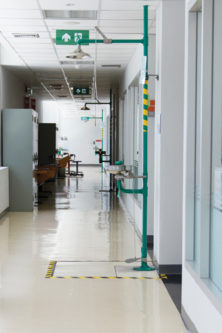Emergency eyewashes and showers

An easily accessible, properly working emergency eyewash and shower station is critical at worksites where, in OSHA’s words, “the eyes or body of any person may be exposed to injurious corrosive materials.”
Emergency eyewash and shower stations provide immediate decontamination and allow workers to flush away hazardous substances, as well as put out clothing fires or flush contaminants off clothing, the Canadian Center for Occupational Health and Safety states.
It’s all about location
Emergency eyewashes and showers must be easily accessible to workers. The American National Standards Institute recommends that a worker be able to reach a station in 10 seconds. CCOHS advises having this emergency equipment even closer, as an injured victim may not be able to see. In addition, emergency eyewashes and showers should be identified with a highly visible sign in a language that all workers can understand. Other tips:
- Keep the area where the emergency eyewash or shower is located well-lit.
- Keep the equipment as close to the hazard as possible and in a place where a worker will not encounter a door, stairs, machinery or other potential hazards.
- Place emergency eyewashes or showers in an area where additional contamination will not occur.
- Ensure a drainage system is in place for excess water to run off. CCOHS points out that the water may be considered hazardous waste and specific regulations may apply.
Use the right unit
Emergency showers are designed to flush a worker’s head and body – not the eyes.
These showers should never be used as eyewashes because the high rate or pressure of the water flow could cause injury, CCOHS states.
Similarly, eyewash stations are meant to flush a worker’s eyes only.
Although combination units exist, CCOHS recommends performing a job hazard analysis to determine the potential hazards in your workplace and what type of unit is best suited for your establishment.
Post a comment to this article
Safety+Health welcomes comments that promote respectful dialogue. Please stay on topic. Comments that contain personal attacks, profanity or abusive language – or those aggressively promoting products or services – will be removed. We reserve the right to determine which comments violate our comment policy. (Anonymous comments are welcome; merely skip the “name” field in the comment box. An email address is required but will not be included with your comment.)

